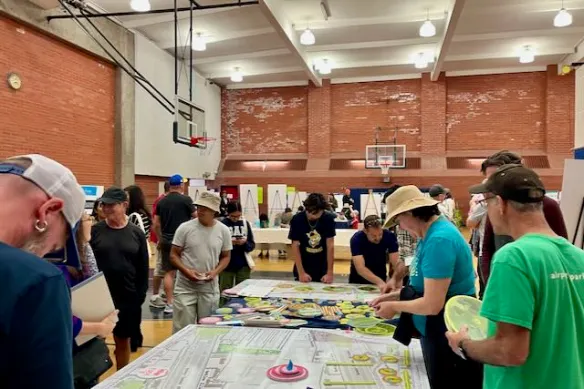The following article first appeared on The Healthy City Local.
Santa Monica Airport is set to close December 31, 2028, and the City’s process to reclaim the city-owned land at the airport and convert it to public use as a great park, the “Santa Monica Airport Conversion Project“, is underway. Sasaki, the consultants hired by the City at the end of 2023, and staff in the Public Works Department have stuck to the schedule originally agreed on. In January City Council adopted “Guiding Principles” and directed Sasaki and staff to come back to council this summer with three different scenarios for the future or the site. From these the council will pick and choose elements to be included in a plan that would by the end of the year be ready for environmental review. (The council’s meeting to do this is scheduled for July 8.)
Over the course of the process, as is de rigueur, Sasaki and staff have conducted considerable public outreach. As is typical the process has made few happy.
In case your memory needs refreshing, the City has been trying to close the airport since the early 80s, when the Federal Aviation Administration (FAA) required the airport to service jets. Under a 1984 agreement, the City gained the right to close the airport in 2015, but at some point after 2000 the FAA disputed the City’s right to do so. Litigation ensued. The aviation industry, fearing the City would win in court, collected signatures to put a measure on the 2014 ballot (“Measure D”) that would have perpetuated the airport by taking away the City Council’s power to close it. The City responded with a counter-measure, Measure LC (“LC,” for “local control”), which provided that once the airport closed, the land could only be developed for parks and recreational purposes, unless other development is approved by a vote of the people.
In the election, Meas. LC defeated Meas. D by a 60-40 margin. Three years later, the City entered into a new agreement with the FAA that definitively gave the City the power to close the airport at the end of 2028.
Disclosures: I am on the board of the Santa Monica Airport2Park Foundation (A2P), which was formed after the election by the committee that ran the campaign in support of LC and against D. We formed A2P to keep the vision of a park alive until the City could close the airport. I am also on the board of the Santa Monica Great Park Coalition (GPC), which was formed last fall. The GPC is a grouping mostly of organizations whose members want to use the park (such as sports organizations) or who believe the park is important for environmental or other social reasons. Our more than 60 organizations represent more than 20,000 members.
Getting back to planning the park, the extensive public process has made few happy. Which is unfortunate, but not unusual. To understand the reactions to the process, you need to know that the politics of the conversion process in Santa Monica have involved, at least so far, not much about the decision to close the airport, but instead whether any of the reclaimed public land should be used for housing.
At first pro-park people, like us in A2P and the GPC, were pleased because the process, in the form of surveys and a well-attended workshop in December, showed tremendous enthusiasm for the park. It was exciting and inspirational to see all the ideas for how these 192 acres, which have been privatized for so many years, could be returned to parkland. (In case you don’t know, the City originally purchased the land in 1926 with a parks bond, and the land was a park until the federal government took it over before World War II so that Douglas Aircraft could build planes there.)

The public process did not show widespread support for building housing on the land, and this result did not please housing proponents. They claimed that the surveys were biased against housing, in part because the surveys identified housing, along with other possible uses of the land, as requiring voter approval under LC. (As an aside, but an important one: many people oppose any effort to amend LC before airport closure, because of the well-grounded fear that in response the aviation industry would come back with a new Meas. D, and because a vote to amend LC now would effectively freeze the planning process for the park. For those reasons it made sense for the planners to identify in the surveys uses that would require a vote.)
Then recently at a Planning Commission meeting, the pro-housing complaints about the process were expanded when UNITE Here, the union representing hotel workers, most of whom are Latino and many of whom have limited English, had been excluded from the process because of inadequate outreach in Spanish and for other technical reasons. UNITE Here is a supporter of the most prominent proposal so far for building housing on the land, called “Cloverfield Commons,” which calls for using half the land to build 3,000 units of affordable housing.
No process is perfect, of course, but this reaction from the pro-housers was not unusual: people who don’t like the results of a process challenge the process. But recently we on the pro-park side have had our own complaints about the process, namely that Sasaki and staff were ignoring the results of their public outreach.
On May 17 Sasaki and staff, at a big event at the airport, released the three scenarios they had prepared in response to council’s direction back in January. Two of the three included considerable amounts of housing. This stunned the pro-park side, who felt blind-sided.
Why? At the meeting in January City Council had directed that one of the three scenarios be compliant with Measure LC. They directed that another of the three would be non-compliant by using development – specifically, to include “some housing” – to support the park financially. The third scenario was left somewhat vague: no one on council or staff said it should include housing, but it was understood that it would not be fully compliant with LC either. That’s because there is a gray area concerning compliance with LC. There are uses that are consistent with what a park is, such as a café or an amphitheater, but which are not currently included in the definition of “park” under the City’s zoning. City Council, however, can amend those ordinances to include other uses consistent with parks, which would then make those uses compliant with LC.
So when two of the three scenarios included lots of housing, not just “some housing” as City Council had asked for, that was a big win for the housers notwithstanding their feelings about the process. It’s natural, however, that we on the park side wonder if our input, and the overall enthusiasm for the park, had been listened to.
So how did this happen?
From the beginning of the process City Council has said that plans for the park should be financially feasible. This is a good thing, and one that we pro-parkers advocated for when the planning process was being started. We don’t want the public to be discouraged by a beautiful, but pie-in-the sky plan that can’t be built because it costs too much.
But that’s not how these processes work. Consultants ask the public what they want, and the public responds by asking for a lot. Designers like to design beautiful things (“make no little plans” as Daniel Burnham (in)famously said), and you can guess what happens.
The result of the direction from the council for financial feasibility was not a starter park that could be built when the airport closes and then expanded over the following years, but two highly aspirational scenarios. The “financial feasibility” solution, if they were going to be built quickly, without waiting for other sources of funds, was to include considerable amounts of on-site “revenue generation.” (While these revenue-generating areas on the maps showing the scenarios were not specifically designated as housing, no one would expect that they would be offices or something else.)
This controversy is unnecessary. The problem with this process, at least as described to the public so far, is that everything is focused on what a completed park would look like, so that the costs of building that park, and the financing that would be available, need to be computed and accounted for now. But the airport is not going to close until December 31, 2028 – more than three and a half years from now – and nothing on the scale shown in the scenarios is likely to be under construction soon after closing.
Not only that, but the idea that housing could pay for the park doesn’t make sense.
I’ll continue this discussion with upcoming posts.
Thanks for reading, and please stay tuned.
